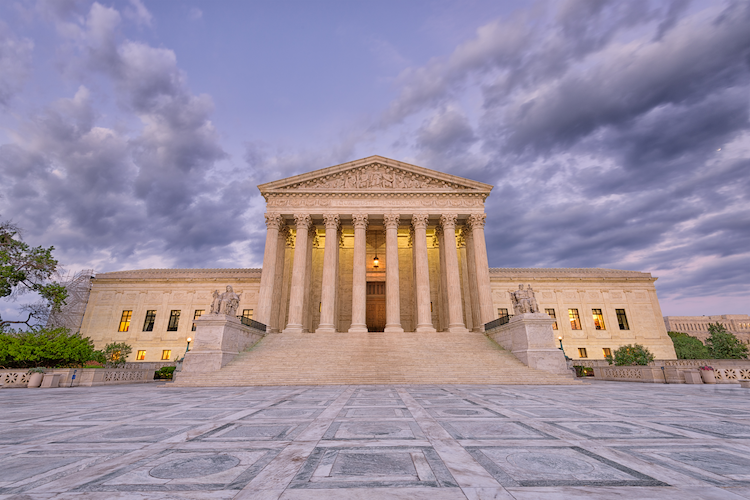SCOTUS Rules Kentucky AG Can Defend Abortion Law

In Cameron v. EMW Women’s Surgical Center, P.S.C., 595 U. S. ____ (2022), the U.S. Supreme Court held that the U.S. Court of Appeals for the 6th Circuit erred in denying the Kentucky attorney general’s motion to intervene on the commonwealth’s behalf in litigation concerning Kentucky House Bill 454, the state’s controversial abortion law.
Facts of the Case
EMW Women’s Surgical Center and two of its doctors filed a federal suit seeking to enjoin enforcement of Kentucky House Bill 454, which regulates the abortion procedure known as dilation and evacuation. The defendants in EMW’s lawsuit included two Commonwealth officials, the attorney general and the cabinet secretary for Health and Family Services. EMW agreed to dismiss claims against the attorney general without prejudice. The stipulation of dismissal specified that the attorney general’s office reserved “all rights, claims, and defenses . . . in any appeals arising out of this action” and agreed to be bound by “any final judgment . . . subject to any modification, reversal or vacation of the judgment on appeal.” The secretary remained in the case and defended the challenged law. After a bench trial, the District Court held that HB 454 unconstitutionally burdens a woman’s right to an abortion and issued a permanent injunction against the law’s enforcement.
The secretary filed a notice of appeal. While the appeal was pending, Kentucky elected a new attorney general, petitioner Daniel Cameron, and elected the former attorney general, Andrew Beshear, Governor. Governor Beshear appointed a new secretary for Health and Family Services who continued the defense of HB 454 on appeal. Prior to oral argument before the Sixth Circuit, Attorney General Cameron entered an appearance as counsel for the new secretary. A divided Sixth Circuit panel affirmed the District Court’s judgment. The secretary then informed the attorney general’s office that the secretary would not file a petition for rehearing en banc or a petition for a writ of certiorari challenging the Sixth Circuit panel’s decision. Two days later, the attorney general moved to withdraw as counsel for the secretary and to intervene as a party on the Commonwealth’s behalf. The secretary did not oppose that motion, but the plaintiffs did. The attorney general also filed a petition for rehearing en banc within the 14-day deadline for an existing party to seek rehearing. The Sixth Circuit denied the attorney general’s motion to intervene.
Supreme Court’s Decision
The Supreme Court reversed by a vote of 8-1, holding that the Sixth Circuit erroneously denied the Kentucky attorney general’s motion to intervene on the commonwealth’s behalf. Justice Samuel Alito wrote on behalf of the Court.
In reaching its decision, the Court noted that no statute or rule provides a general standard to apply in deciding whether intervention on appeal should be allowed. Instead, the Court was guided by the “policies underlying intervention” in the district courts, including the legal “interest” that a party seeks to “protect” through intervention on appeal.
The Court subsequently found that the Sixth Circuit panel “failed to account for the strength of the Kentucky attorney general’s interest in taking up the defense of HB 454,” emphasizing that a State clearly has a legitimate interest in the continued enforceability of its own statutes. “A state’s opportunity to defend its laws in federal court should not be lightly cut off,” Justice Alito explained. “Respect for state sovereignty must also take into account the authority of a state to structure its executive branch in a way that empowers multiple officials to defend its sovereign interests in federal court.”
The Supreme Court also found that the Sixth Circuit erred in its evaluation of the other factors that bear on all applications for appellate intervention, including its assessment of the timeliness of the attorney general’s motion to intervene. As Justice Alito explained, while an important consideration, timeliness depends on the circumstances, and the progression of the litigation is “not solely dispositive.”
In this case, the Court found that the most important circumstance relating to timeliness was that the attorney general sought to intervene “as soon as it became clear” that the Commonwealth’s interests “would no longer be protected” by the parties in the case. “The attorney general sought to intervene two days after learning that the secretary would not continue to defend HB 454. The motion was also filed within a week after the Sixth Circuit issued its decision and within the 14-day time limit for petitioning for re- hearing en banc,” Justice Alito wrote. “Although the litigation by that time had proceeded for years, that factor is not dispositive. The attorney general’s need to seek intervention did not arise until the secretary ceased defending the state law, and the timeliness of his motion should be assessed in relation to that point in time.”
The Supreme Court found that the Sixth Circuit’s finding on prejudice was similarly flawed. The Court noted that while the attorney general’s rehearing petition pressed an issue (third-party standing) not raised in the secretary’s appellate briefs, allowing intervention would not have necessitated resolution of that issue. Moreover, respondents’ loss of its claimed expectations around election of a Governor with a history of declining to defend abortion restrictions is not cognizable as unfair prejudice in the sense relevant to the case. Justice Sonia Sotomayor was the lone dissenter. She argued that the Court’s decision will “open the floodgates for government officials to evade the consequences of litigation decisions made by their predecessors of different political parties, undermining finality and upsetting the settled expectations of courts, litigants, and the public alike.”
Previous Articles
Key Cases to Watch During the Supreme Court’s November Sitting
by DONALD SCARINCI on November 5, 2025
The U.S. Supreme Court’s November sitting begins on November 3 and concludes on November 12, 2025...
SCOTUS Clears Way to Terminate Protected Status for Venezuelan Nationals
by DONALD SCARINCI on October 29, 2025
On October 3, 2025, the U.S. Supreme Court granted an emergency request from the Trump Administrati...
Supreme Court Cases to Watch in the October Sitting
by DONALD SCARINCI on October 23, 2025
The U.S. Supreme Court’s new term, which began on October 6, has the potential to be historic. In...
The Amendments
-
Amendment1
- Establishment ClauseFree Exercise Clause
- Freedom of Speech
- Freedoms of Press
- Freedom of Assembly, and Petitition
-
Amendment2
- The Right to Bear Arms
-
Amendment4
- Unreasonable Searches and Seizures
-
Amendment5
- Due Process
- Eminent Domain
- Rights of Criminal Defendants
Preamble to the Bill of Rights
Congress of the United States begun and held at the City of New-York, on Wednesday the fourth of March, one thousand seven hundred and eighty nine.
THE Conventions of a number of the States, having at the time of their adopting the Constitution, expressed a desire, in order to prevent misconstruction or abuse of its powers, that further declaratory and restrictive clauses should be added: And as extending the ground of public confidence in the Government, will best ensure the beneficent ends of its institution.





